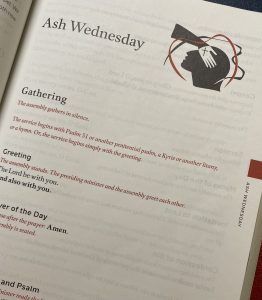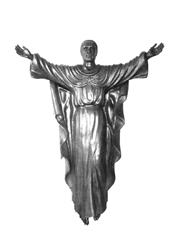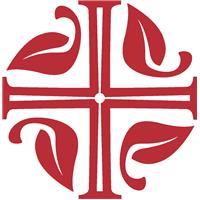As congregations and worship leaders prepare for Ash Wednesday in this most challenging year, the ELCA Worship team offers this set of reflections by those serving the church as scholars, pastors, and bishops. Our hope is that their perspectives will provide thinking points as you reflect and prepare worship in your context.
 Repentance is at the core of Christian living (the first of Luther’s 95 Theses). During the season of Lent, we all become a “penitent” with ashes on the forehead, looking toward to the cross as a sign of God’s reconciliation with all creation (with the absolution on Maundy Thursday). Ashes appear throughout the Hebrew Bible as a sign of mourning and repentance, but Isaiah reminds us that such practices point to the larger call for justice (Isa. 58:5-6). These ashes are at the very beginning (“dust” in Genesis 3:19) and connect each of us to all of creation and to our own mortality.
Repentance is at the core of Christian living (the first of Luther’s 95 Theses). During the season of Lent, we all become a “penitent” with ashes on the forehead, looking toward to the cross as a sign of God’s reconciliation with all creation (with the absolution on Maundy Thursday). Ashes appear throughout the Hebrew Bible as a sign of mourning and repentance, but Isaiah reminds us that such practices point to the larger call for justice (Isa. 58:5-6). These ashes are at the very beginning (“dust” in Genesis 3:19) and connect each of us to all of creation and to our own mortality.
Ash Wednesday reflection has taken on new meaning because of the coronavirus. Some may argue that a specific day or season is not necessary since signs of impending death are all around us as the pandemic continues to claim thousands of lives and impacts millions more. But the coronavirus is not only a reminder of mortality but also the result of sins. Let me be clear here – I do not mean that the pandemic is punishment for sin, but rather that the spread of the pandemic has been aided by the sins of “neglect of human need and suffering” and “our lack of concern for those who come after us.”
The popularity of ashes-on-the-go highlights that Ash Wednesday can be commemorated outside the church building. For the sake of safety, the imposition of ashes should only take place with those in the household. Congregations could provide ashes (traditionally made from burning last year’s palm branches), or households could make their own – even all-wood charcoal would work.
When participating in digital worship, those in the household could impose ashes on each other during the appointed time in the liturgy. Those worshiping at home could use the litany of confession as a conversation guide, discussing (and then acting on) how to live into the disciplines of Lent: “self-examination and repentance, prayer and fasting, sacrificial giving and works of love.” It is not enough to just remember that “we are dust, and to dust we shall return.” As ones marked as Christ’s own children, we heed the call to repent, to ‘turn around.’
Prof. Kyle Schiefelbein-Guerrero is Steck-Miller Assistant Professor of Worship and Liturgy at United Lutheran Seminary. Prof. Schiefelbein-Guerrero explores “Living the Liturgical Year in Pandemic Times” in a new video series. Look for an entry about Ash Wednesday in the coming weeks.
 The power of receiving the cross on our foreheads on Ash Wednesday is in the layering: there is a sign of sin and death traced and layered on top of the tracing in water and oil of the promise of life, rebirth, and liberation from sin and death. On Ash Wednesday, we feel the full weight of the ashy tracing. It does not negate or obliterate the liberating sign it is layered with, but it is a suitably tangible reminder of the reality of grief, loss, and death.
The power of receiving the cross on our foreheads on Ash Wednesday is in the layering: there is a sign of sin and death traced and layered on top of the tracing in water and oil of the promise of life, rebirth, and liberation from sin and death. On Ash Wednesday, we feel the full weight of the ashy tracing. It does not negate or obliterate the liberating sign it is layered with, but it is a suitably tangible reminder of the reality of grief, loss, and death.
The questions that have helped guide my reflections and exploration of Ash Wednesday this year have been basic: What is Ash Wednesday? What does it do? I’ve found help in the ELW Pattern for Worship (Pew Edition, p. 248; Leader’s Desk Edition, p. 612.) That led me to Welcome to Baptism (ELW Pew Edition, p. 232; Leader’s Desk Edition, p. 592), which led me to conversation with Episcopalian and Roman Catholic folks involved in the ecumenical catechumenate. Michael Marchal, a Roman Catholic writer and educator, and I talked about the ancient origins of Ash Wednesday (more focused on penitence) and creative possibilities for adapting the rite this year. We found common ground in a focus on baptism and the cross. The cross we trace on each other within our households or on ourselves is an embodied reminder that God is where we’d least expect an all-powerful being to be; a connection to both the reality of sin and death as well as to the promise of baptism.
Blessings on your caring and creative approaches to Ash Wednesday this year. It will be different; things are different this year. Christ will meet you there.
Bishop Anne Edison-Albright is Bishop of the East-Central Synod of Wisconsin. An expanded version of this reflection is found on Bishop Edison-Albright’s blog.
 Most of my personal study and continuing education for the last several months has been focused on trauma-informed care, recognizing that living through the varied events of the last year affects not only our spirit but also our mind and body, and requires adaptations honoring this challenging new space. A best practice for trauma-informed care is to remember that significant stress and trauma are not just intellectual exercises. Our bodies respond to and reflect the events of the day. It may be using prayer beads or a finger labyrinth to make home worship feel more real or wrapping myself in a favorite sweater or soft blanket when I miss the comforting hugs of family and friends. Being mindful of how my body responds to grief and loss and finding ways to care for and comfort it has been both personally and professionally beneficial.
Most of my personal study and continuing education for the last several months has been focused on trauma-informed care, recognizing that living through the varied events of the last year affects not only our spirit but also our mind and body, and requires adaptations honoring this challenging new space. A best practice for trauma-informed care is to remember that significant stress and trauma are not just intellectual exercises. Our bodies respond to and reflect the events of the day. It may be using prayer beads or a finger labyrinth to make home worship feel more real or wrapping myself in a favorite sweater or soft blanket when I miss the comforting hugs of family and friends. Being mindful of how my body responds to grief and loss and finding ways to care for and comfort it has been both personally and professionally beneficial.
Ash Wednesday is such a powerful experience because we experience it physically. Even when our minds are not fully able to understand the scope of what is to come, when our spirits reject the pain of Jesus’ last days, our bodies remember. Wearing the cross of ashes as a bodily exercise is Jesus meeting us in our body’s anxiety and sadness and being with us there. As an Ash Wednesday discipline, I am encouraging my parishioners to consider ways their body can hold the day’s realities. What rituals, symbols, or actions can help us confront the fragile beauty of these brief, powerful moments of life? How can we remember that we are called to journey with Jesus and pray with him over the next 40 days, knowing what is to come? Our minds may not have the answer, but our bodies carry ancient wisdom.
The Rev. Carla S. Christopher Wilson is Assistant to the Bishop in Charge of Justice Ministries for Lower Susquehanna Synod, ELCA and Associate Pastor of Faith Formation and Outreach at Lutheran Church of the Good Shepherd in Lancaster, Pennsylvania.
 Ash Wednesday marks the beginning of a journey when we remember Jesus’ ministry, his ability to heal and care for humanity, and at the same time, his passion, death, and overall, his glorious resurrection. In a “typical” year it might seem too soon to even talk about Easter on Ash Wednesday. However, I don’t know if that’s the case for 2021.
Ash Wednesday marks the beginning of a journey when we remember Jesus’ ministry, his ability to heal and care for humanity, and at the same time, his passion, death, and overall, his glorious resurrection. In a “typical” year it might seem too soon to even talk about Easter on Ash Wednesday. However, I don’t know if that’s the case for 2021.
We have been in a sort of Ash Wednesday and Lenten journey for so long already. We have been on a journey in which we have witnessed pain, suffering, and even death. More and more people dying due to COVID-19, political upheaval in the nation, racism, LGBTQIA+ discrimination, violence, injustice, poverty, and many other issues seem endless. We yearn for that Easter moment.
Before Easter happened two millennia ago there was suffering, pain, anguish, uncertainty, fear, and death. Although pain and suffering are not God’s desire for us, they are an inevitable reality in this human life both then and now.
We say or hear on Ash Wednesday the remarkable phrase: “You are dust and to dust you shall return.” This year it can be an invitation for us to talk and grieve with our communities about how awfully painful these days are. We are invited to do so, however, while keeping the other real fact in mind: Those words are said and heard on a day in which we also know that, even in the midst of suffering and death, Easter is also our reality.
May your Ash Wednesday proclamation and celebration this year be a glimpse of realistic hope that will help us to face together these excruciating and painful times. We know that Easter will come. Though tomorrow is uncertain, we do know that Christ is risen! He is risen indeed, Hallelujah!
The Rev. Alejandro Mejia is Chaplain Resident at John Hopkins Hospital in Baltimore, Maryland.
Image Credits: Pearls of Life. Permission is granted to copy, distribute and/or modify this document under the terms of the GNU Free Documentation License. Ugandan Risen Christ, from Art in the Christian Tradition, a project of the Vanderbilt Divinity Library, Nashville, TN.
 In the Easter season our “Alleluias” are bold. Many of the hymns and songs chosen for Easter have a majestic and joyful quality to them. Bells, brass, and drums often enhance organ, piano, or guitar. Yet we know that even though we are a resurrection people, we can’t always shout our praise or exude joy. “Christ has risen while earth slumbers,” a new hymn in All Creation Sings, announces the promise of resurrection while acknowledging the complexity of human experience. In the words of stanza three:
In the Easter season our “Alleluias” are bold. Many of the hymns and songs chosen for Easter have a majestic and joyful quality to them. Bells, brass, and drums often enhance organ, piano, or guitar. Yet we know that even though we are a resurrection people, we can’t always shout our praise or exude joy. “Christ has risen while earth slumbers,” a new hymn in All Creation Sings, announces the promise of resurrection while acknowledging the complexity of human experience. In the words of stanza three: 

 the Lutheran School of Theology at Chicago focusing on womanist theology, race, and history. Denise was a member of the Liturgy Working Group for
the Lutheran School of Theology at Chicago focusing on womanist theology, race, and history. Denise was a member of the Liturgy Working Group for 
 Repentance is at the core of Christian living (the first of Luther’s 95 Theses). During the season of Lent, we all become a “penitent” with ashes on the forehead, looking toward to the cross as a sign of God’s reconciliation with all creation (with the absolution on Maundy Thursday). Ashes appear throughout the Hebrew Bible as a sign of mourning and repentance, but Isaiah reminds us that such practices point to the larger call for justice (Isa. 58:5-6). These ashes are at the very beginning (“dust” in Genesis 3:19) and connect each of us to all of creation and to our own mortality.
Repentance is at the core of Christian living (the first of Luther’s 95 Theses). During the season of Lent, we all become a “penitent” with ashes on the forehead, looking toward to the cross as a sign of God’s reconciliation with all creation (with the absolution on Maundy Thursday). Ashes appear throughout the Hebrew Bible as a sign of mourning and repentance, but Isaiah reminds us that such practices point to the larger call for justice (Isa. 58:5-6). These ashes are at the very beginning (“dust” in Genesis 3:19) and connect each of us to all of creation and to our own mortality. The power of receiving the cross on our foreheads on Ash Wednesday is in the layering: there is a sign of sin and death traced and layered on top of the tracing in water and oil of the promise of life, rebirth, and liberation from sin and death. On Ash Wednesday, we feel the full weight of the ashy tracing. It does not negate or obliterate the liberating sign it is layered with, but it is a suitably tangible reminder of the reality of grief, loss, and death.
The power of receiving the cross on our foreheads on Ash Wednesday is in the layering: there is a sign of sin and death traced and layered on top of the tracing in water and oil of the promise of life, rebirth, and liberation from sin and death. On Ash Wednesday, we feel the full weight of the ashy tracing. It does not negate or obliterate the liberating sign it is layered with, but it is a suitably tangible reminder of the reality of grief, loss, and death. Most of my personal study and continuing education for the last several months has been focused on trauma-informed care, recognizing that living through the varied events of the last year affects not only our spirit but also our mind and body, and requires adaptations honoring this challenging new space. A best practice for trauma-informed care is to remember that significant stress and trauma are not just intellectual exercises. Our bodies respond to and reflect the events of the day. It may be using prayer beads or a finger labyrinth to make home worship feel more real or wrapping myself in a favorite sweater or soft blanket when I miss the comforting hugs of family and friends. Being mindful of how my body responds to grief and loss and finding ways to care for and comfort it has been both personally and professionally beneficial.
Most of my personal study and continuing education for the last several months has been focused on trauma-informed care, recognizing that living through the varied events of the last year affects not only our spirit but also our mind and body, and requires adaptations honoring this challenging new space. A best practice for trauma-informed care is to remember that significant stress and trauma are not just intellectual exercises. Our bodies respond to and reflect the events of the day. It may be using prayer beads or a finger labyrinth to make home worship feel more real or wrapping myself in a favorite sweater or soft blanket when I miss the comforting hugs of family and friends. Being mindful of how my body responds to grief and loss and finding ways to care for and comfort it has been both personally and professionally beneficial. Ash Wednesday marks the beginning of a journey when we remember Jesus’ ministry, his ability to heal and care for humanity, and at the same time, his passion, death, and overall, his glorious resurrection. In a “typical” year it might seem too soon to even talk about Easter on Ash Wednesday. However, I don’t know if that’s the case for 2021.
Ash Wednesday marks the beginning of a journey when we remember Jesus’ ministry, his ability to heal and care for humanity, and at the same time, his passion, death, and overall, his glorious resurrection. In a “typical” year it might seem too soon to even talk about Easter on Ash Wednesday. However, I don’t know if that’s the case for 2021.